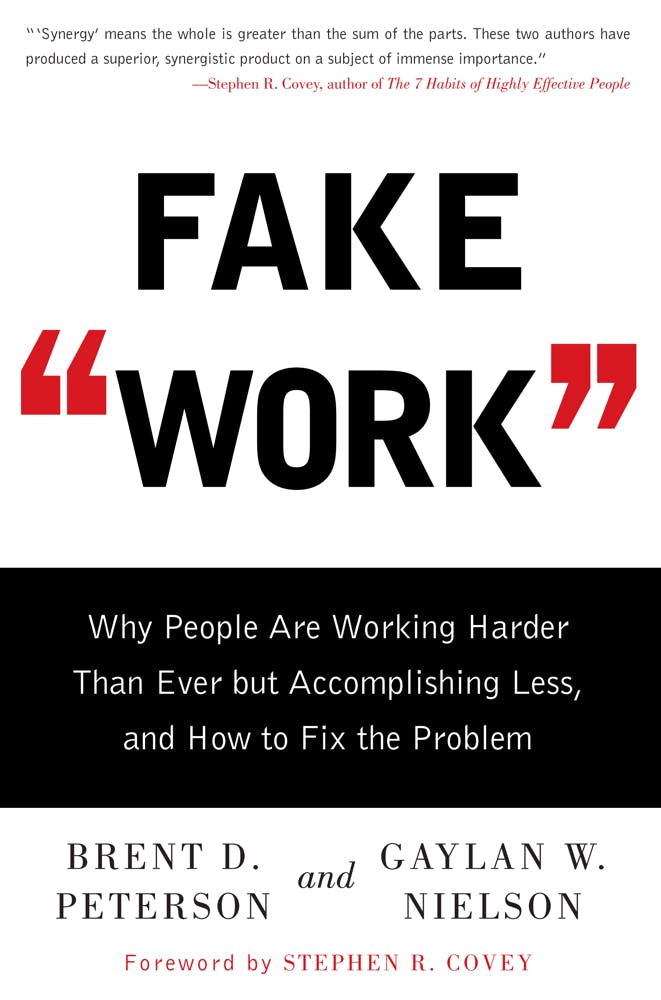By Brent D. Peterson and Gaylan W. Nielson
Many factors help create fake-work cultures.
Many corporate processes, like decision making, change management, communication, and operations, are rife with fake work. But leadership and management are the standard-bearers for fake-work cultures. Below are some common characteristics of fake-work cultures:
- Autocratic leaders. Autocratic leaders have launched entire ships of fake work by pursuing a product or an initiative that many know is heading totally in the wrong direction. Millions of dollars’ worth of fake work can happen with a single directive.
- Cavalier leaders. In many companies, leaders fail to establish the environment for success and to aid alignment and execu- tion. When they don’t take those roles seriously, they enable the wrong behaviors.
- Unclear business and strategic plans. Writing and communicating strategic plans is worthless if employees remain clueless about strategic direction. One company told us that it had invested heavily in linking its people to its plans. But our research showed that over 70 percent of the employees there had no real understanding of the strategies.
- A lack of clear company values. Values are the navigational stars in a company. If managers do not articulate them, model and live them, monitor and set expectations to follow them, people will do work that fails the best intentions of the company. Articulating a value like “safety” can mean the difference between success and failure in an organization.
- Being removed from the customer. Cultures that don’t stay close to customer needs create fake work by guessing incorrectly about those needs. Companies also need to help focus staff functions, HR, legal support, and IT because they are notorious fake-work spawning sites where lots of gaps open up between programs and real work.
- Short-sighted thinking. Business often suffers from having only one strategy — maximizing profits. Every other strategy becomes a victim to short-term profits. Sometimes companies cut costs in areas like customer service for short-term gains. A ton of people then end up shifting their work to deal with customer complaints, lagging sales, and angry stockholders.
- Arrogance and complacency. Some companies can’t imagine that the competition will ever catch up. Those companies are monuments to fake work because they don’t listen to their employees, their customers, and the trends in the marketplace.
- A constant influx of new systems, structures, and procedures. Companies too often work on new systems that cause tons of work to get them up, running, and implemented. In an effort to improve effectiveness, companies target process change without ensuring that they are linked to the business goals they are addressing.
- Old-school performance management processes. In most companies, the way they manage, review, and reward performance is totally ineffective. These processes don’t help manage performance at all.
- Failure to train and build managers. The investment in managers and the insistence on managers of high quality and high value are minimal in too many companies.
- A tendency to hire people without clear expectations tied to competencies and company goals. People are hired all the time to fill a position rather than to focus on a problem or to bring a set of competencies to a role.
- Fast growth without controls. Some companies have created cultures that are often exciting to work in because everything seems like real work, critical work, and people are passionate about it. However, fake work isn’t just what you are doing, sometimes it is what you are not doing. Over time, much of your work can become fake.
These factors that affect company culture will ultimately alter the culture that you may be pursuing or hoping for.
Excerpted from Fake Work – Why People Are Working Harder Than Ever But Accomplishing Less, and How to Fix the Problem, by Brent D. Peterson and Gaylan W. Nielson. Copyright 2009 by Simon Spotlight Entertainment, a division of Simon & Schuster. Reprinted by permission.
